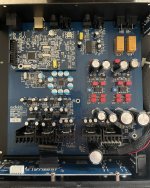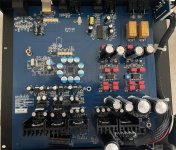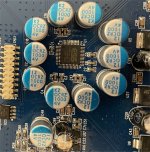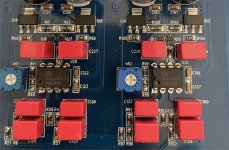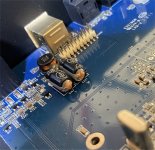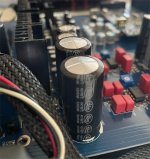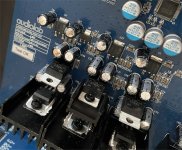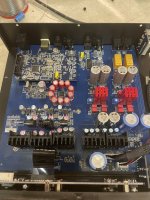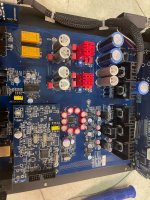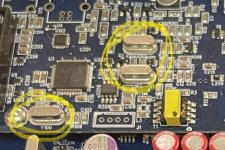Hello
Thread created to document 'upgrades' to an Audiolab Q-DAC. Hopefully useful to others by the end
This is apparently the M-DACs poorer sibling, but it has proper 8 pin DIP output op-amps and enough functionality to also pose as a pre-amp
This thing wasn't super expensive on a well known auction site so I went for it. I swapped out my STAX DAC talent and the initial reaction was 'meh, well at least it works'
After a week or so of listening it was time to "pop the hood"
So Pictures!!
Andy
Thread created to document 'upgrades' to an Audiolab Q-DAC. Hopefully useful to others by the end
This is apparently the M-DACs poorer sibling, but it has proper 8 pin DIP output op-amps and enough functionality to also pose as a pre-amp
This thing wasn't super expensive on a well known auction site so I went for it. I swapped out my STAX DAC talent and the initial reaction was 'meh, well at least it works'
After a week or so of listening it was time to "pop the hood"
So Pictures!!
Andy
Attachments
So here follows a slightly incomplete list of electrolytic Capacitors - MM means 'obstructed couldn't see the value' and I didn't bother with the USB daughterboard (it's 220at 16v)
470uF/6.3v on a 5v line? = 🤮
The polymer 4v ones around the DAC look fine though
things to do...
Andy
470uF/6.3v on a 5v line? = 🤮
The polymer 4v ones around the DAC look fine though
| C | uF | Volt |
| 2 | 1000 | 4 |
| 4 | 1000 | 4 |
| 6 | 1000 | 4 |
| 8 | 1000 | 4 |
| 10 | 1000 | 4 |
| 12 | 1000 | 4 |
| 14 | 1000 | 4 |
| 16 | 1000 | 4 |
| 18 | 1000 | 4 |
| 20 | 1000 | 4 |
| 22 | 100 | 25 |
| 26 | 470 | 6.3 |
| 29 | 470 | 6.3 |
| 31 | 100 | 25 |
| 35 | 470 | 6.3 |
| 41 | 470 | 6.3 |
| 44 | 470 | 6.3 |
| 49 | 1000 | 4 |
| 58 | 100 | 25 |
| 62 | 100 | 25 |
| 64 | 100 | 25 |
| 67 | mm | mm |
| 69 | 470 | 6.3 |
| 85 | 470 | 6.3 |
| 87 | 470 | 6.3 |
| 89 | 470 | 6.3 |
| 104 | 470 | 6.3 |
| 112 | 470 | 6.3 |
| 138 | 4700 | 16 |
| 140 | 4700 | 16 |
| 144 | 100 | 25 |
| 146 | 100 | 25 |
| 147 | 470 | 6.3 |
| 152 | 4700 | 16 |
| 153 | 4700 | 16 |
| 162 | 4700 | 16 |
| 166 | 4700 | 16 |
| 187 | 4700 | 25 |
| 188 | 4700 | 25 |
| 189 | 4700 | 25 |
| 196 | 100 | 25 |
| 201 | 470 | 6.3 |
| 205 | 470 | 6.3 |
| 221 | 470 | 6.3 |
things to do...
Andy
So
Fairly under whelming except that I seem to have missed a few caps from the shopping list
Burson op-amps because they are 1/2 price at the moment, I "relaxed" the connections on the surrounding film caps (aka re-soldered). Come on though make the flipping op-amps fit Burson!!
Now need to fully understand the pot - I have essentially zero DC on the output so functionally all good
Most importantly it sounds OK too, the thinness had gone but since it was about to go the full 'mission impossible' I guess its just been brought up/back to normal
Andy
Fairly under whelming except that I seem to have missed a few caps from the shopping list
Burson op-amps because they are 1/2 price at the moment, I "relaxed" the connections on the surrounding film caps (aka re-soldered). Come on though make the flipping op-amps fit Burson!!
Now need to fully understand the pot - I have essentially zero DC on the output so functionally all good
Most importantly it sounds OK too, the thinness had gone but since it was about to go the full 'mission impossible' I guess its just been brought up/back to normal
Andy
Attachments
Odd but old Lelon caps were known for premature failure (like Audiolab is for using such brands) and today's Lelon caps are OK. Question is when they changed to normal quality. Just to be sure and on the safe side I consider them to be OK after 2020. I saw many defective ones but never the polymer versions.
Did you actually compare the Burson with OPA134PA?
Good job BTW!
Did you actually compare the Burson with OPA134PA?
Good job BTW!
Last edited:
It's hard to tell the date no obvious clue on the chassis - from 2013.Odd but old Lelon caps were known for premature failure (like Audiolab is for using such brands) and today's Lelon caps are OK. Question is when they changed to normal quality. Just to be sure and on the safe side I consider them to be OK after 2020. I saw many defective ones but never the polymer versions.
all the 470uf that were popping. it could even have been a bad batch or the DAC was kept somewhere warm.
No, Not yet, if it wasn't for the 'faff' of opening the case I'd be all over that (cue OPA627 etc) but its bound to happen. its the reason I looked for a 'Q' rather than an 'M'Did you actually compare the Burson with OPA134PA?
I really don't mind the '134 series but this is really a case of replacements required and the Bursons were pretty cheap. They're pushing the V7 now so the V6 is the ugly sister?
Also this is for my first 'from a PC' streamer thing, so I don't really have a comparison just yet. I'm waiting to see if on-line convenience beats fanfare of putting little silver discs in a tray.
Andy
Hi! And here we see potential to upgrade, but it needed to design some small boards with clocks to put them on this 2 pin places
That's the USB daughterboard. I do not pretend to understand the clock magic there! There is another oscillator marked (in pen) 800 on the main PCB that seems key to events too.
I really need a service manual
Andy
That USB board make minimum 50% work in DAC if using PC (but I think much more). Even that 12/13 or 24 Mhz crystal on XMOS matters a lot, another two we need to ring the schematics. Already started a project to swap those crap crystals:That's the USB daughterboard. I do not pretend to understand the clock magic there!
Hi! Want to share an idea about upgrading crystals to good oscillators. Here is a probe of such one, while studiyng KiCad. First one is for upgrade 2pin crystals in HC-49/US case (11.35mm x 5.00mm, 5mm spacing between legs). Capacitor C4 is optional and needed in cases where logic level is higher than 3.3V, in other cases we solder a jumper instead. Regulator voltage 1.8/3.3V need to be choosen depending to logic level, according to datasheet of IC. XO pin need to cut and I propose to use it hole as gnd for adapter and it's out need to be connected to XI pin/hole. I would be glad to...
- Anatolii_A
- Replies: 4
- Forum: Digital Line Level
It's surely something I have read about this DACThat USB board make minimum 50% work in DAC if using PC (but I think much more). Even that 12/13 or 24 Mhz crystal on XMOS matters a lot, another two we need to ring the schematics. Already started a project to swap those crap crystals:
I will watch your thread.
At this point I am still experimenting with SPDIF / USB
Andy
I don't have such DAC but I can say I hear a massive improvement in every another places where I've swapped ususal crystal to normal oscillator. Clock and it's power source on USB/SPDIF receiver decides almost everything.
Depending on the existing design, you could potentially make the sound end up worse by random hacking of clocks. Probably better if you could first find or else sketch up a schematic of the existing clocking design so it can be seen what else the crystals are connected to....but it needed to design some small boards with clocks to put them on this 2 pin places...
True to an extent, but often the clock is then buffered by a CPLD. Some improvement still comes through, but a lot can be lost by going through a CPLD.Clock and it's power source on USB/SPDIF receiver decides almost everything.
Don't scare people to try and listen 🙂Depending on the existing design, you could potentially make the sound end up worse by random hacking of clocks
The same improvent of clocks I hear in any places where it could be, with XMOS/SAVITECH/ComTrue. By the way, Savitech bravo (and ComTrue) with onboard PLL with good power supply and good clocks sounds very nice and I must say that developers of not expensive usb processors have reached a very good level. Not one XMOSTrue to an extent, but often the clock is then buffered by a CPLD.
Replacing ordinary crystal with a clock requires other modifications as well. The load capacitors that ordinary crystal requires should be removed if clock is used.Don't scare people to try and listen
Another thing is that audio clocks should probably not be used as system clock (MCK) with ES9016 as it works asynchronously.
Of course, think it is clear. Instead don't do anything with your devices.The load capacitors that ordinary crystal requires should be removed if clock is used.
Replacing ordinary crystal with a clock requires other modifications as well.
Hi! Want to share an idea about upgrading crystals to good oscillators. Here is a probe of such one, while studiyng KiCad. First one is for upgrade 2pin crystals in HC-49/US case (11.35mm x 5.00mm, 5mm spacing between legs). Capacitor C4 is optional and needed in cases where logic level is higher than 3.3V, in other cases we solder a jumper instead. Regulator voltage 1.8/3.3V need to be choosen depending to logic level, according to datasheet of IC. XO pin need to cut and I propose to use it hole as gnd for adapter and it's out need to be connected to XI pin/hole. I would be glad to...
- Anatolii_A
- Replies: 4
- Forum: Digital Line Level
That is the crystal used by the DAC chip. If you have an oscilloscope you could check the frequency although not necessarily worthwhile to do any modifications to that. No need to replace the crystals on the USB board.There is another oscillator marked (in pen) 800 on the main PCB that seems key to events too.
So why do you spend money on NDK clocks in your devices? Put such crystals instead.No need to replace the crystals on the USB board.
It is better to spend money wisely instead of following a dogma. In this case the clocks on the USB board are only used for generating I2S signals but not MCK. For most DS dacs MCK is only critical.
- Home
- Source & Line
- Digital Line Level
- Audiolab Q-DAC
